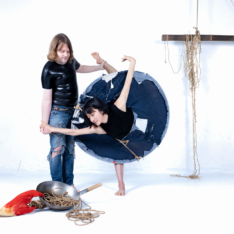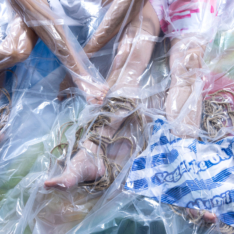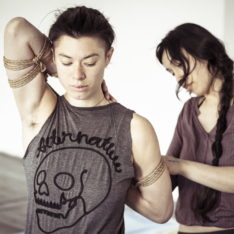Es beginnt mit einer unerwarteten Erkenntnis: Ich habe noch nie YumYum-Nudeln gegessen. Während ich mich in die Einlassschlange zur Premiere des nach dem populären Instant-Gericht betitelten Stückes anstelle, denke ich ergebnislos über die Unkenntnis des Naheliegenden nach. Es wird nicht das letzte Mal an diesem Abend sein, dass mir etwas unbegreiflich bleibt. Drinnen wartet vor der Tribüne ein großer gemütlicher Teppich auf das Publikum, der in eine wunderliche Bühneninstallation buchstäblich ausfranst: Von der Decke hängen auf unterschiedlicher Höhe mehrere halbvoll mit Wasser gefüllte transparente Plastikbeutel, an den weißen Vorhängewänden lehnen einige lange Holzstäbe, im hinteren Teil der Bühne hängt ein riesiges Seilknäuel, das in Gedenken an die Überschrift der Aufführung sofort an Nudeln erinnert, und vorn am Bühnenrand steht, ebenfalls auf einem Haufen Seilbündel, ein großer Wok (Bühnenbild: Dasniya Sommer). In einer von meinem Platz aus kaum einsehbaren Nische am Bühnenrand wird eine der Performer*innen von drei anderen beiläufig verschnürt und auf eine suspension vorbereitet, während ein anderer Performer bedächtig zwischen den Wasserbeuteln umherläuft und dabei Worte vor sich hin spricht, die wahrscheinlich eine Zutatenliste ergeben. Jedes Mal, wenn sich mir etwas zu erhellen scheint, wird gleichzeitig etwas anderes undurchsichtig.
Im fünfköpfigen intersektionalen Ensemble von „Yum Yum“, das neben Sommer aus Michael Schumacher, Yui Kawaguchi, Tara Jade Samaya und Fungi Fung besteht, treffen unterschiedliche künstlerische Praktiken aufeinander: Schauspiel, Ballett, Mixed Martial Arts, zeitgenössischer Tanz und die japanische Fesselkunst Shibari. Damit ist bereits das Fundament gelegt für eine Ästhetik des Eklektischen, die immer wieder gängige Gegensätze in Frage stellt und dabei unerwartete Verknüpfungen generiert. In einer gleichsam poetisch wie brutal wirkenden Szene tanzen Sommer, Kawaguchi und Samaya eine Folge von Ballett-Schritten — haben dabei aber ihre Knie, ihre Arme vor der Brust oder ihre Hände hinter dem Rücken verbunden. Das kann als Kritik an der Disziplinierung des Körpers im Ballett gelesen werden, aber auch als Sinnlichkeit der Restriktion. In einem anderen Moment treten Sommer und Kawaguchi, deren Körper ich beide als asiatisch lese, als Nintendo-Marios mit Einkaufstüten-Tütü auf, die zu Game Boy-Musik eher bemüht als leichtfüßig eine Ballett-Choreografie tanzen (Sound Design, Composition: Nguyễn + Transitory). Damit unterlaufen sie einerseits Perfektionserwartungen, die sowohl ans Ballett als auch an asiatische Körper gestellt werden, und stellen gleichzeitig auf absurde Weise den dem Ballett zugrunde liegenden enorm artifiziellen Stil heraus, den es normalerweise unter dem hart erarbeiteten Schein von müheloser Natürlichkeit zu verstecken versucht. Während sich Schumacher daran macht, im Wok eine echte Nudelsuppe zuzubereiten, freue ich mich über das unverschämte Angebot, über Ballett als YumYum-Suppe nachzudenken.
Unter dem Flickenteppich der überall verteilten YumYum-Werbeplakate und der unterschiedlichen Szenen der Aufführung blitzt immer wieder das Thema antiasiatischer Rassismus auf. Sehr unumwunden drückt es sich in einem vielstimmigen Chor verschiedener marginalisierter Lebensrealitäten aus. Während die Aufnahme läuft und die Performer*innen die Bühne verlassen, verbinden sich Geschichten über Kochen und Essen mit denen über Arbeit und Migration. Doch auch der Auseinandersetzung mit den ästhetischen und vielleicht auch politischen Möglichkeiten von Künstlichkeit, die sich wie ein roter Faden durch „Yum Yum“ zieht, ist das Thema inhärent. Die Literaturwissenschaftlerin Anne Anlin Cheng, die zur langen Geschichte der Ästhetisierung des weiblichen asiatischen Körpers forscht, beschreibt das Potential von Künstlichkeit beispielsweise in fashion als „temporary relief from the burdens of having bodies and their inevitable weighty visibility“ insbesondere für rassifizierte Personen. Künstlichkeit kann ein Ort des Schutzes genauso wie der Gewalt sein, das führt auch das Stück immer wieder vor. Zum Schluss werden all die unzähligen Utensilien auf der Bühne zu einem riesigen Sack zusammengeschnürt, und die Performer*innen verschwinden unter voluminösen Perücken und langen Umhängen. Zu gespenstischer Musik im Dämmerlicht bleibt die Zeit stehen, und es verdampfen alle Differenzen zu einer für mich undefinierbaren Suppe voller überraschender ästhetischer Geschmacksrichtungen. Und so verdichtet sich all das Ungreifbare am Ende doch noch zu einer demütigen Erkenntnis für mich: meiner Unvertrautheit mit den mich umgebenden Alltagsrealitäten der asiatischen Diaspora. Dagegen helfen sicher auch keine Instant-Nudeln, wohl aber zeitintensive Performance-Zubereitungen wie dieser Abend.
„Yum Yum“ von Haus Sommer (Tanz/Choreografie/Bühnenbild: Dasniya Sommer; Tanz/Co-Choreografie/Performance: Michael Schumacher, Yui Kawaguchi, Tara Jade Samaya, Fungi Fung), Premiere: 12.05.2023, ist noch bis zum 14.05.2023 im Ballhaus Ost zu sehen, Tickets unter ballhausost.de.






























